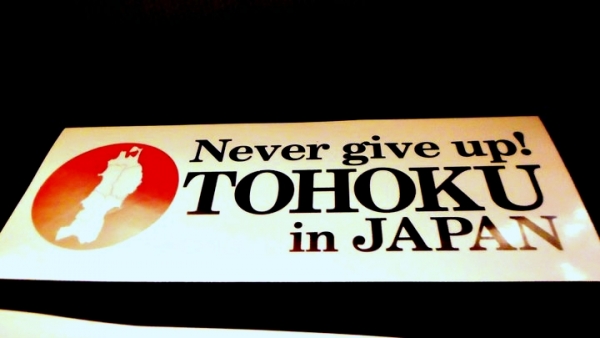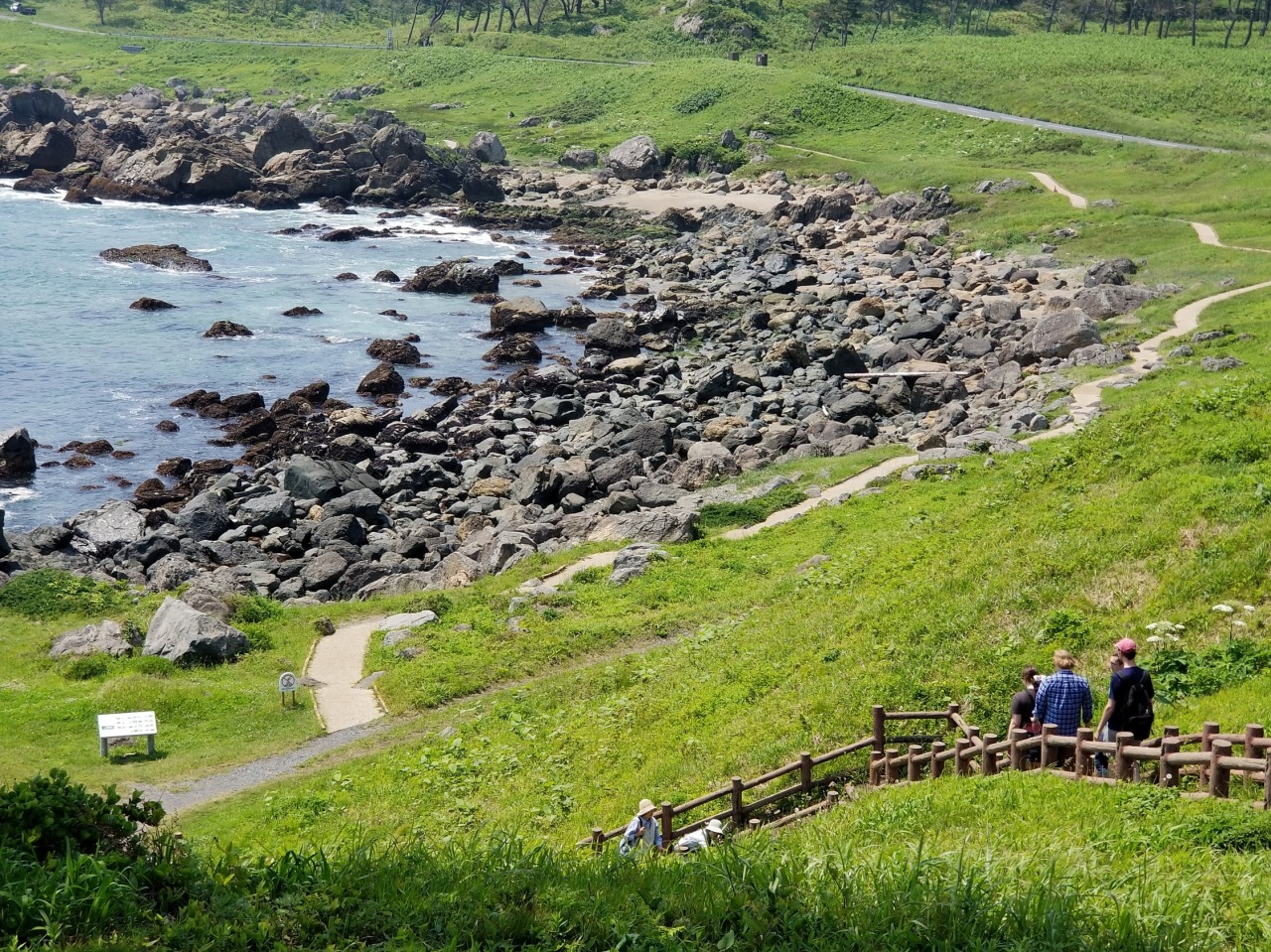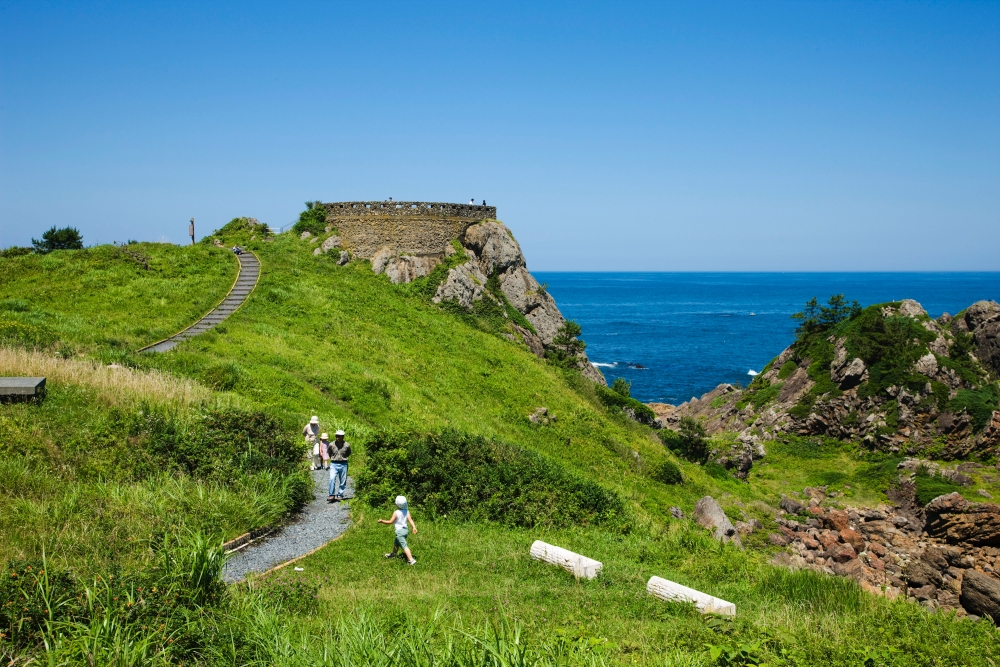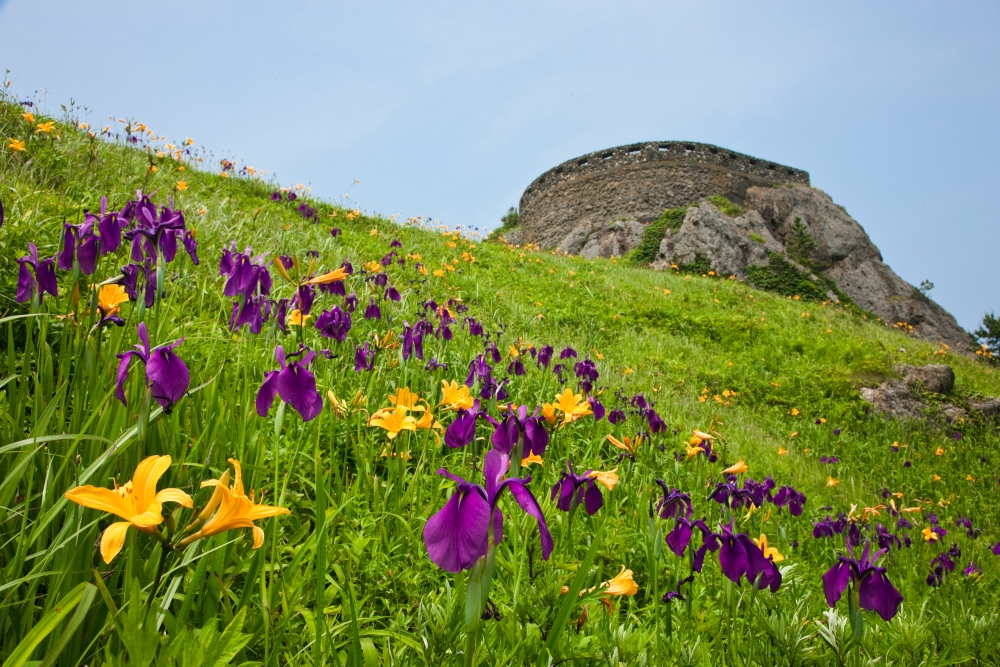San-sational Sanriku Part 2: Supporting recovery through tourism

Facing the Pacific Ocean, the 600km-long Sanriku Coast (三陸海岸 Sanriku-kaigan) in Tohoku stretches from Aomori Prefecture through Iwate Prefecture and until Miyagi Prefecture. Due to its location, this rugged coastline has been subjected to numerous destructive tsunami over the past centuries.
The most recent one, the 2011 Great Eastern Japan Earthquake and Tsunami (東日本大震災 Higashi-nihon daishinsai), occurred barely a few years ago, badly battering many of the coastal communities along the Sanriku Coast. Even until today, many of the towns and cities are still reeling from the destruction, and continue to work on reconstruction and recovery.

Local volunteers welcoming incoming visitors. (Image credit: JR East)
Other than for the multitude of mesmerising scenery and scrumptious seafood, more and more visitors are heading to the Sanriku region to support recovery efforts. Simply staying a night or having a meal would help the local community, and more importantly, let them know that you have not forgotten about them, and that you are rooting for them.
In this article, we will explore some of the tourism recovery efforts that have been undertaken by the region, and where you can visit to learn more about the 2011 disaster.
Note: This is Part 2 of a two-part series dedicated to tourism along the Sanriku Coast. Part 1 focused on travelling along the Sanriku Railway Rias Line, while Part 2 will focus on tourism recovery and reconstruction efforts in the area.
The Michinoku Coastal Trail

Walking along the Michinoku Coastal Trail. (Image credit: 東北観光推進機構)
A symbol of recovery for the Tohoku region’s Pacific Coast, the Michinoku Coastal Trail (みちのく潮風トレイル Michinoku Shiokaze Toreiru) is a foot trail stretching 1,000km from the island of Kabushima (蕪島) in Aomori Prefecture to Matsugawaura (松川浦) in Fukushima Prefecture. Recently opened in June 2019, it is meant to be explored on foot, and passes through diverse terrain and coastal villages.
It is hoped that through exploring the Michinoku Coastal Trail (MCT), visitors will be able to learn more about the places it passes through, through interaction with the local communities. Michinoku is the old name for the region comprising the four prefectures of Aomori, Iwate, Miyagi, and Fukushima, all of which were hit hard by the 2011 disaster.
Much of the MCT is located within the Sanriku Fukko National Park (三陸復興国立公園 Sanriku Fukkō Kokuritsu Kōen), which was created in 2013 and aims to let visitors experience the rich nature and culture of Sanriku, as well as to learn about the threat of tsunamis.
The MCT's entire 1,000km would be a bit too much for a single trip, so here I will introduce two scenic and educational sections:
- Hachinohe Section day trip: from Same Station to Tanesashikaigan Station
- 2D1N Jodogahama-Taro Route: from Miyako Station to Taro Station
A day trip to the Hachinohe Section
Kabushima Shrine

Kabushima Shrine on the island of Kabushima. (Image credit: 青森県観光連盟)
The Hachinohe Section of the MCT begins at the trail’s starting point, and meanders around the scenic Tanesashi Coastline (種差海岸 Tanesashi kaigan). The tiny island of Kabushima (蕪島), a 15-minute walk from the nearest train station, JR Same Station (鮫駅) on the JR Hachinohe Line (八戸線), is the starting point of the Michinoku Coastal Trail.
This island is a nesting ground for black-tailed gulls (うみねこ umineko), and you can often catch the sight of thousands of gulls gathered around Kabushima Shrine between March and August. The shrine completely burnt down in 2015, but has recently re-opened in March 2020.
Ashigezaki Viewpoint

Ashigezaki Viewpoint. (Image credit: 青森県観光連盟)
A 30-minute walk from Kabushima brings you to the Ashigezaki Viewpoint (葦毛崎展望台Ashigezaki Tenbо̄dai). This lookout was formerly used by the military in World War II, but is now open to public, and provides panoramic views of the Tanesashi Coastline. This spot is one of the main stops along the Hachinohe Section.
Flowers at Nakasuka Coast

Colourful flowers at Nakasuka. (Image credit: 青森県観光連盟)
Nearby is the Nakasuka Coast (中須賀海岸 Nakasuka-kaigan), whose bright and beautiful blossoms have earned it the nickname of Hana no Nagisa (花の渚), which means “shore of flowers”.
The flowers that bloom at Nakasuka (best season: mid-June–mid-July) overcome a harsh climate to bloom, an act that reminds the local community of their own efforts and perseverance against the hardships they face. The beautiful scenery is not only a sight to behold, but also reminds visitors to keep on persevering.
Singing sand at Osuka Beach

Osuka Beach. (Image credit: 青森県観光連盟)
Continue walking for 15 minutes and you will reach Osuka Beach (大須賀海岸 О̄suka kaigan), which has a special feature: singing sand. It is so named as the sand makes a squeaking sound when you step on it, and seems to “sing” as you walk! The beach stretches for over 2km, so take care as it gets a little tricky walking on sand.
Yodo Pinegrove

Strolling through Yodo Pinegrove. (Image credit: 青森県観光連盟)
Another hour’s walk will bring you past Shirahama Beach, Fukakubo Fishing Port, and Shiraiwa, before you arrive at Yodo Pinegrove (淀の松原 Yodo-no-Matsubara), a pine-filled forest with trees that are over a century old. While walking through the pine forest, you can get a glimpse of the Pacific Ocean peeking through the trees.
Tanesashi Natural Lawn

Vast expanses of the Tanesashi Natural Lawn. (Image credit: 青森県観光連盟)
After walking through the Yodo Pinegrove, you will reach the Tanesashi Natural Lawn (種差天然芝生地 Tanesashi Ten’nen Shibafuchi) in about 20 minutes. This vast expanse of greenery offers an unobstructed view of the Pacific Ocean, and the fields offer a welcome respite after hours of walking.
The Tanesashi Natural Lawn is a 3-minute walk from JR Tanesashikaigan Station (種差海岸駅) on the Hachinohe Line. From Tanesashikaigan Station, you can take a 70-minute ride on the Hachinohe line to Kuji Station, the start of the Sanriku Railway Rias Line.
Video of hiking along the Michinoku Coastal Trail Hachinohe Section. (Video credit: Apple Chiba)
A 2D1N trip along the Jodogahama-Taro Route
The second route I will introduce is the longer Jodogahama-Taro Route. In addition to scenic spots, the Jodogahama-Taro Route also passes by places and facilities damaged by the 2011 earthquake and tsunami, providing opportunities to learn more about the event and letting you get a tiny glimpse at how it affected the local community.
The beautiful Jodogahama Beach
Jodogahama Beach. (Image credit: JR East / Shibata)
The route starts at Jodogahama Beach (15 minutes by bus from Miyako Station), which is considered by many to be one the most beautiful places in Iwate. Thankfully, Jodogahama Beach was spared destruction during the 2011 tsunami. It is said that this beach was as beautiful as the Buddhist Paradise (浄土 Jо̄do) and was thus named Jodogahama, which translates to “Pure Land Beach”. Here you can enjoy a breathtaking panorama of calm blue waters surrounding the white pebble shoreline, contrasting with the jagged rock formations in the ocean.
Setting off from Jodogahama Beach, walk for a little over 3 hours and you will reach the Shiofuki-ana (潮吹穴), a blowhole from which seawater gushes upwards. In higher tides, the height of the blowhole’s water can reach a whopping 30m. 10 minutes from Shiofuki-ana is Kyukamura Rikuchu-Miyako (休暇村陸中宮古), a hotel where you can rest for the night before continuing on the trail the following morning.
Tsunami Memorial Park NAKANOHAMA

The Tsunami Memorial Park NAKANOHAMA. (Image credit: 東北観光推進機構)
The next morning, a 40-minute walk from the hotel will bring you to the Tsunami Memorial Park NAKANOHAMA (震災メモリアルパーク中の浜 Shinsai Memoriaru Pāku Nakanohama) which was opened in 2014. The park is located on a stretch of the beach that was affected by the 2011 tsunami and earthquake. At the park, you can explore the damaged campsites, which were left as is, and head over to the Observation Hill (展望の丘 Tenbо̄-no-oka), from which you can look out of at the same height as the tsunami. This is a place where you cannot help feeling the horror of the tsunami.
Taro Kanko Hotel

Exterior of the Taro Kanko Hotel. (Image credit: 東北観光推進機構)
Continue walking and 4.5 hours later you will reach the Taro Kanko Hotel (たろう観光ホテル Tarо̄ Kankо̄ Hoteru), which was badly hit by the 2011 tsunami. The 17m-high tsunami had flooded up to the fourth floor of the six-storey hotel, and completely destroyed the first and second floors, sweeping away everything but the steel frames.
The hotel has since been renovated, and the building currently serves as an educational facility to pass down the terrors of the tsunami as a lesson. To enter the building, visitors will need to climb up to the fifth storey, from where they can experience a view at the height of the tsunami.
Inside, you can go on a disaster prevention tour (advanced reservations required), and see actual footage of the tsunami approaching, filmed from the sixth floor of the hotel on the day of the disaster. The fees for the tours contribute to supporting the region’s reconstruction efforts.
Sannoiwa Rocks

The Sannoiwa Rocks. (Image credit: 岩手県観光協会)
From Taro Kanko Hotel. walk for 20-minutes and you will reach Sanno Park (三王園地 Sannо̄-enchi), where you can get a view of the Sannoiwa Rocks (三王岩Sannо̄-iwa)—a set of three rocks that were created by erosion from the Pacific Ocean’s waves and wind. The three rocks are the tall 50m Male Rock (男岩 Otokoiwa), the 23m-high Female Rock (女岩 Onnaiwa), and the drum-shaped Taiko Rock (太鼓岩 Taiko-iwa).
Sanno Park is a 30-minute walk from Tarо̄ Station (田老駅) on the Sanriku Railway Rias Line.
If you are interested in other sections of the MCT, you can check out their English website here. The site offers details maps and information (in English) for various sections of the trail.
The Sanriku Railway Rias Line
Railway lines along the Sanriku Coast in Iwate. (Image credit: JR East / Carissa Loh)
Running for 163km along the Sanriku Coast from Kuji Station (久慈駅) in the north to Sakari Station (盛駅) in the south, the Sanriku Railway Rias Line (三陸鉄道リアス線 Sanriku Tetsudо̄ Riasu-sen) is the main railway serving the Sanriku Coast. Less damaged sections were up and running by 5 days after the 2011 tsunami, and the full line resumed operations in March 2019. The railway has since become a symbol of hope and resilience for the region. I have written more about travelling along this railway line in Part 1 of this series, which you can check out here.
Rikuzentakata’s road to recovery
Bus Rapid Transit (BRT)
The BRT runs along the Sanriku Coast between Sakari and Maeyachi. (Image credit: JR East)
The Sanriku Railway Rias Line ends at Sakari Station, but here it connects with JR East’s BRT (bus rapid transit). BRT are buses that partially use former railway tracks which were not rebuilt after the disaster. Switching to a bus system allowed for greater frequency, which better served the local community.
The BRT is divided into two sections which join at Kesennuma Station, where you can also transfer to the JR East train line:
- BRT Ofunato Line: Sakari (盛) to Kesennuma (気仙沼) (85 minutes, 43.7km)
- BRT Kesennuma Line: Kesennuma (気仙沼) to Maeyachi (前谷地) (140 minutes, 72.8km)
The BRT passes by some of the worst-hit places from the 2011 tsunami, one of which is Rikuzentakata (陸前高田), a small city in the south of Iwate. Rikuzentakata was one of the cities hit hardest by the tsunami in 2011, when 13m-high waves practically wiped out most of the structures in the city; sweeping away 80% of homes, and leaving 1,606 dead and 202 missing.

Takata Matsubara before the 2011 tsunami. (Image credit: 岩手県観光協会)
Before the 2011 earthquake and tsunami, Rikuzentakata was known for Takata Matsubara (高田松原), a pine forest where 70,000 beautiful pine trees lined a 2km shoreline. After the tsunami, only a single tree survived the disaster; the rest were swept away.
The Miracle Pine, a symbol of hope

Rikuzentakata’s Miracle Pine in August 2011. (Image credit: JR East / Carissa Loh)
The remaining 200-year-old tree was dubbed the Miracle Pine (奇跡の一本松 Kiseki no ippon matsu), and became a symbol of the local community’s resilience and hope.
My first visit to Tohoku was in 2011, as part of a volunteer program for the 2011 Great East Japan Earthquake and Tsunami, and one of the places we went to was Rikuzentakata. While cleaning up debris at Rikuzentakata barely 5 months after the disaster, it was impossible not to feel overwhelmed when thinking about the destruction and devastation that had ravaged Tohoku a few months prior.

Rikuzentakata 5 months after the tsunami. (Image credit: JR East / Carissa Loh)
What used to be a populated coastal town was literally flattened; nothing could be seen in the distance except for piles of debris, crushed cars, and buildings reduced to their steel supports. I felt so small in that vast area of land; the destruction and debris seemed so much bigger, and the impact and scale of the destruction felt magnified. I can't imagine what the people living there must have felt.
We had been tasked with clearing drains which had been blocked and covered with debris and mud, hardened over time by the weather. But despite a collective effort over a few hours, all we could clear was a small section. Imagine all the time and effort needed to get the whole town back to recovery.
In the years since the tsunami, Rikuzentakata’s city centre has been rebuilt on higher elevations as a precaution for future disasters, and efforts to rebuild the city are still ongoing.
Takata Matsubara Tsunami Memorial Park

The reinstalled Miracle Pine and the Takata Matsubara Tsunami Memorial Park. (Image credit: JR East / Shibata)
Although the Miracle Pine eventually died due to salt toxicity, it was preserved and reinstalled as a memorial, becoming part of the Takata Matsubara Tsunami Memorial Park (高田松原津波復興祈念公園 Takatamatsubara Tsunami Fukkō Kinen Kōen). The space that the new park occupies used to be where the Takata Matsubara pine forest once stood.
The park houses a roadside station, Michi-no-eki Takata Matsubara, as well as the recently-opened Iwate Tsunami Memorial Museum (東日本大震災津波伝承館 いわてTSUNAMIメモリアル Higashi-nihon Daishinsai Tsunami Denshō-kan Iwate Tsunami Memoriaru).
Iwate Tsunami Memorial Museum

Inside the Iwate Tsunami Memorial Museum. (Image credit:東北観光推進機構)
Opened in September 2019, the Iwate Tsunami Memorial Museum explains the 2011 tsunami—the science behind it, lessons to learn, and how local people have faced the disaster. Inside the museum, you can view photographs of and relics from the tsunami. Don’t worry about the language, the museum offers bilingual explanations in both English and Japanese.
Iwate Tsunami Memorial Museum (東日本大震災津波伝承館 いわてTSUNAMIメモリアル)
Address: 180 Dotekage, Kesencho, Rikuzentakata-shi, Iwate 029-2204
Access: From JR Kesennuma Station, take the BRT Ofunato Line (35-minute ride) and get off at the Kiseki-no-Ippon-Matsu (Miracle Pine) (奇跡の一本松駅) bus stop. The museum is next to the bus stop. If you’re coming from Sakari Station, the BRT ride from Sakari to Kiseki no Ipponmatsu is about 55 minutes.
Opening hours: 09:00–17:00 (Closed during 29 December–3 January)
Admission: Free
Tel: +81-192-47-4455
Singapore Hall at the Rikuzentakata Community Hall

The Rikuzentakata Community Hall and the friendship plaque. (Image credit: JR East / Shibata)
Singaporeans might be surprised to know that we have a connection with Rikuzentakata. Thanks to the support of Singaporeans, aid from the Singapore Red Cross was used to undertake several projects in Rikuzentakata, including scholarships for students and the construction of several facilities. The largest project was the Rikuzentakata Community Hall (陸前高田市コミュニティーホール, which opened in May 2015.
 Inside the Singapore Hall during the first Singapore Fair in Rikuzentakata. (Image credit: Vivid Creations)
Inside the Singapore Hall during the first Singapore Fair in Rikuzentakata. (Image credit: Vivid Creations)
Serving as a multi-purpose recreational and business space for the residents of Rikuzentakata, the main hall of the Rikuzentakata Community Hall was christened the Singapore Hall (シンガポールホール) to mark the ties for friendship between the two cities. Rikuzentaka was slated to be the host town for Singapore athletes for the 2020 Tokyo Olympics, which has unfortunately been postponed due to COVID-19.
2021 Tohoku Destination Campaign

(Image credit: JR East / Carissa Loh)
Through my trips to Tohoku, I have found that Tohoku is a vibrant place filled with some of the warmest and most hospitable people I’ve ever met. As I have been doing since my first visit, I continue to encourage family, friends, and acquaintances to drop by the Tohoku (and Sanriku) region, to see for themselves all the amazing scenery, food, and cultural experiences it has to offer.
Now, nine years after the disaster, the Tohoku region is starting to make its way back to the travel lists, making it to #3 on Lonely Planet’s Best in Travel 2020, and landing a spot on National Geographic’s Best Trips to take in 2020.
2021 will mark 10 years after the 2011 Great Eastern Japan Earthquake and Tsunami, and Japan will be launching a 6-month long Destination Campaign (DC) for the Tohoku Region; to thank the public for their continued support, as well as to encourage more visitors to the region. Although we cannot travel due to the current COVID-19 situation, Tohoku (and Sanriku) will always be warmly waiting for your next visit!
Getting there
Same Station (start of MCT Hachinohe Section)
- From Tokyo, take the Tohoku Shinkansen to Hachinohe Station (八戸駅) (2 hours 45 minutes), then transfer to the JR Hachinohe Line to Same Station (鮫駅) (20 minutes).
Miyako Station (start of MCT Jodogahama-Taro Route)
- From Tokyo, take the Tohoku Shinkansen to Morioka Station (盛岡駅) (2 hours 15 minutes), then transfer to the JR Yamada Line to Miyako Station (宮古駅) (2 hours 15 minutes).
Rikuzentakata
- From Tokyo, take the Tohoku Shinkansen to Ichinoseki Station (一ノ関駅) (2 hours), transfer to the JR Ofunato Line to Kesennuma Station (気仙沼駅) (85 minutes), then transfer to the BRT Ofunato Line bound for Sakari Station and get off at the Kiseki-no-Ippon-Matsu (Miracle Pine) Bus Stop (35 minutes).
JR EAST PASS (Tohoku area)
 The new JR EAST PASS (Tohoku area) and usage area. (Image credit: JR East)
The new JR EAST PASS (Tohoku area) and usage area. (Image credit: JR East)
If you are visiting the Tohoku region to explore the Sanriku Coast or the Michinoku Coastal Trail, check out the JR EAST PASS (Tohoku area), an affordable pass offering unlimited rail travel on JR East lines (including bullet trains and BRT) in the valid area for 5 consecutive days. At only ¥30,000, it costs less than a round-trip between Tokyo and Same (~¥33,000), or Tokyo and Miyako (~¥33,000). You can also make seat reservations online for free, up to 1 month in advance, on the JR-EAST Train Reservation. The JR EAST PASS (Tohoku area) can be used for automatic ticket gates, and foreign passport holders living in Japan are also eligible to use this pass.

The JR-EAST Train Reservation. (Image credit: JR East)
Although the Sanriku Railway Rias Line is not covered by the JR EAST PASS (Tohoku area), Sanriku Railway offers a variety of 1-day and 2-day passes for use on weekends and public holidays, which you can check out here.
Header image credit: JR East / Carissa Loh




